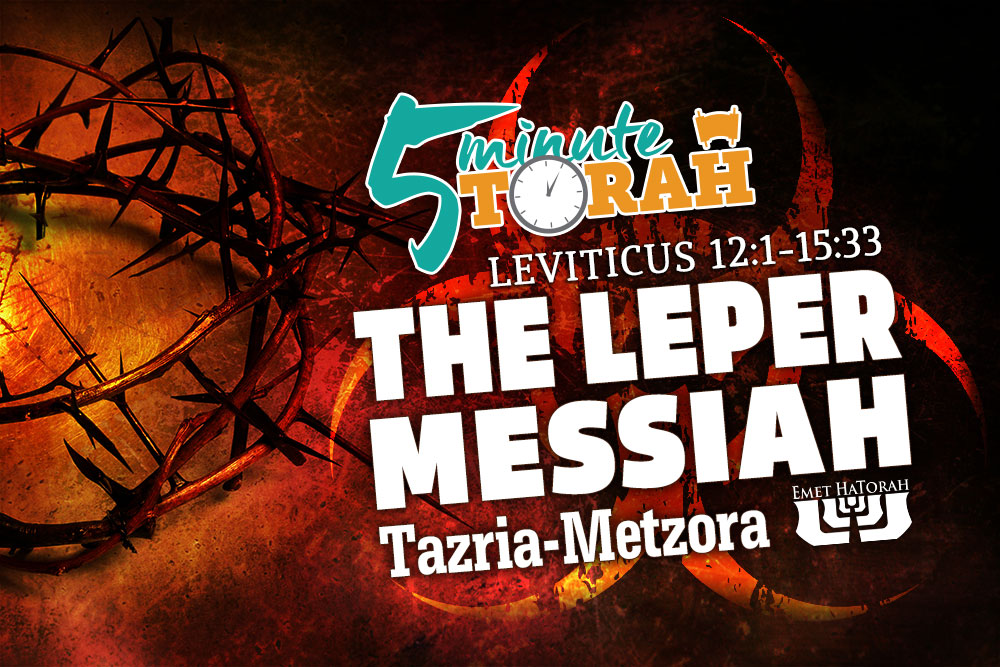Parashat Tazria-Metzora - Leviticus 12:1-15:33
Series:

The Leper Messiah
Parashat Tazria begins by discussing the purification rituals of childbirth and then quickly moves into the complicated laws of biblical leprosy. As we have discussed previously, biblical leprosy is not your standard pathological disorder, but rather an affliction that is spiritual in nature. This ancient malady does not exist today, but we read about cases of its appearance during the biblical period. And although it wasn’t contagious in the manner of a bacterial or viral infection, it could be transmitted from one person to another. The leper was to remain isolated the entire duration of his affliction:
The leprous person who has the disease shall wear torn clothes and let the hair of his head hang loose, and he shall cover his upper lip and cry out, “Unclean, unclean.” He shall remain unclean as long as he has the disease. He is unclean. He shall live alone. His dwelling shall be outside the camp. (Leviticus 13:45–46)
At the end of Parashat Metzora we have a series of laws dealing with bodily discharges and the ramifications of ritual impurity they create. One such issue is a woman who has a discharge of blood outside of her normal cycle:
If a woman has a discharge of blood for many days, not at the time of her menstrual impurity, or if she has a discharge beyond the time of her impurity, all the days of the discharge she shall continue in uncleanness. As in the days of her impurity, she shall be unclean. Every bed on which she lies, all the days of her discharge, shall be to her as the bed of her impurity. And everything on which she sits shall be unclean, as in the uncleanness of her menstrual impurity. And whoever touches these things shall be unclean, and shall wash his clothes and bathe himself in water and be unclean until the evening. (Leviticus 15:25–27)
Each of these examples are focused on the contraction of ritual impurity. Anyone who touched a person in either one of these extreme states of ritual impurity would become unclean themselves. However, this presents a problem for most readers of the Gospels. During one of his return visits to the Galilee, Yeshua encountered a leper who begged him for healing (Mark 1:40–44). Yeshua, being filled with compassion, touched the leper, healing him instantly. In another instance, Yeshua is walking through a crowd and a woman “with an issue of blood” came and touched his tzit-tzit and was immediately healed as well (Matthew 9:20–22).
In each of these cases, Yeshua came into contact with someone with a serious case of ritual impurity. The question we must ask is, did he become ritually unclean himself? Most followers of Yeshua would respond with an emphatic, “No.” This common belief, however, is tied to a fundamental misunderstanding of both the nature of ritual impurity and also the ministry of Yeshua.
First, ritual impurity (being “unclean”) is in no way equivalent to sin. Ritual contamination was a routine part of life during the days when the Holy House was standing. Women became ritually impure during their monthly cycle or during childbirth. Both men and women became unclean with any kind of bodily emission. Tzara'at (biblical leprosy), however, was one of the most severe cases of ritual impurity. And when a woman had an unusual flow of blood, her contamination could spread simply through items she touched. However, in each of these cases (and all cases of ritual impurity), being ritually impure was not a sin in and of itself. If a person became ritually unclean, it did not mean he had sinned. The only way sin was connected to ritual impurity is if an unclean person entered the Holy Temple. In this case they would be guilty of defiling the earthly abode of the Almighty, an extremely serious offense, and be held liable for their lives.
So, did Yeshua become unclean when he touched the leper or the woman with the issue of blood? According to a Talmudic interpretation of Isaiah 53:4, the Messiah takes upon himself leprosy (and other impurities) so that he might bear our afflictions:
The Rabbis said: His name is “the leper scholar,” as it is written, “Surely he hath borne our griefs, and carried our sorrows: yet we did esteem him a leper, smitten of God, and afflicted.” (b.Sanhedrin 98b)
Yeshua used this understanding as evidence that he was indeed the long-awaited Messiah when questioned by the disciples of John the Immerser:
And Jesus answered them, “Go and tell John what you hear and see: the blind receive their sight and the lame walk, lepers are cleansed and the deaf hear, and the dead are raised up, and the poor have good news preached to them.” (Matthew 11:4-5)
He became the Leper Messiah for our sake, bearing our griefs and carrying our sorrows by intentionally touching the lepers and those who were unclean, taking upon himself their afflictions. Rather than speaking a word of healing and remaining ritually pure himself, his compassion and empathy guided his hand to reach out and touch the impurity of another. No, he did not break out in white scabs. He did, however, become ritually impure for our sake.








